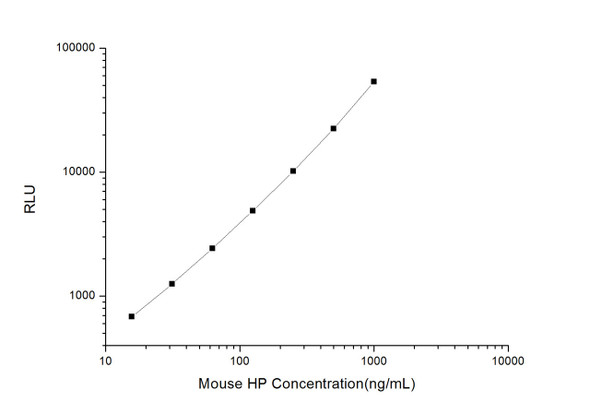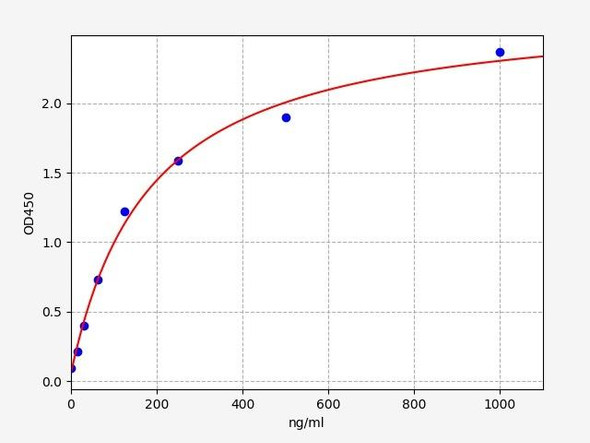Rat Signaling ELISA Kits 3
Rat HP (Haptoglobin) CLIA Kit (RTES00273)
- SKU:
- RTES00273
- Product Type:
- ELISA Kit
- ELISA Type:
- CLIA Kit
- Size:
- 96 Assays
- Sensitivity:
- 1.88ng/mL
- Range:
- 3.13-200ng/mL
- ELISA Type:
- Sandwich
- Synonyms:
- Hpt, BP, Hp2-Alpha, HPA1S
- Reactivity:
- Rat
- Sample Type:
- Serum, plasma and other biological fluids
- Research Area:
- Immunology
Description
| Assay type: | Sandwich |
| Format: | 96T |
| Assay time: | 4.5h |
| Reactivity: | Rat |
| Detection method: | Chemiluminescence |
| Detection range: | 3.13-200 ng/mL |
| Sensitivity: | 1.88 ng/mL |
| Sample volume: | 100µL |
| Sample type: | Serum, plasma and other biological fluids |
| Repeatability: | CV < 15% |
| Specificity: | This kit recognizes Rat HP in samples. No significant cross-reactivity or interference between Rat HP and analogues was observed. |
This kit uses Sandwich-CLIA as the method. The micro CLIA plate provided in this kit has been pre-coated with an antibody specific to Rat HP. Standards or samples are added to the appropriate micro CLIA plate wells and combined with the specific antibody. Then a biotinylated detection antibody specific for Rat HP and Avidin-Horseradish Peroxidase (HRP) conjugate are added to each micro plate well successively and incubated. Free components are washed away. The substrate solution is added to each well. Only those wells that contain Rat HP, biotinylated detection antibody and Avidin-HRP conjugate will appear fluorescence. The Relative light unit (RLU) value is measured spectrophotometrically by the Chemiluminescence immunoassay analyzer. The RLU value is positively associated with the concentration of Rat HP. The concentration of Rat HP in the samples can be calculated by comparing the RLU of the samples to the standard curve.
| UniProt Protein Function: | HP: Haptoglobin combines with free plasma hemoglobin, preventing loss of iron through the kidneys and protecting the kidneys from damage by hemoglobin, while making the hemoglobin accessible to degradative enzymes. Defects in HP are the cause of anhaptoglobinemia (AHP). AHP is a condition characterized by the absence of the serum glycoprotein haptoglobin. Serum levels of haptoglobin vary among normal persons: levels are low in the neonatal period and in the elderly, differ by population, and can be influenced by environmental factors, such as infection. Secondary hypohaptoglobinemia can occur as a consequence of hemolysis, during which haptoglobin binds to free hemoglobin. Belongs to the peptidase S1 family. |
| UniProt Protein Details: | Protein type:Enzyme, misc. ; Protease; Endoplasmic reticulum; Secreted, signal peptide; Secreted Cellular Component: endoplasmic reticulum; extracellular region; extracellular space; Golgi apparatus Molecular Function:antioxidant activity; hemoglobin binding; protein homodimerization activity; serine-type endopeptidase activity Biological Process: acute inflammatory response; acute-phase response; defense response to bacterium; immune system process; liver development; negative regulation of oxidoreductase activity; Notch signaling pathway; organ regeneration; proteolysis; response to cobalamin; response to drug; response to electrical stimulus; response to glucocorticoid stimulus; response to heat; response to hydrogen peroxide; response to hypoxia; response to L-ascorbic acid; response to lead ion; response to lipopolysaccharide; response to magnesium ion; response to organic cyclic substance; response to organic substance; response to X-ray; spermatogenesis |
| NCBI Summary: | may bind hemoglobin and mediate hemoglobin catabolism in lung cells; may play a role in inflammatory response [RGD, Feb 2006] |
| UniProt Code: | P06866 |
| NCBI GenInfo Identifier: | 60097941 |
| NCBI Gene ID: | 24464 |
| NCBI Accession: | NP_036714. 2 |
| UniProt Secondary Accession: | P06866,Q5EBB4, Q7TP23, |
| UniProt Related Accession: | P06866 |
| Molecular Weight: | 40. 5 kDa |
| NCBI Full Name: | haptoglobin |
| NCBI Synonym Full Names: | haptoglobin |
| NCBI Official Symbol: | Hp |
| NCBI Official Synonym Symbols: | Ba1-647 |
| NCBI Protein Information: | haptoglobin |
| UniProt Protein Name: | Haptoglobin |
| UniProt Synonym Protein Names: | Liver regeneration-related protein LRRG173; Zonulin |
| UniProt Gene Name: | Hp |
| UniProt Entry Name: | HPT_RAT |
As the RLU values of the standard curve may vary according to the conditions of the actual assay performance (e. g. operator, pipetting technique, washing technique or temperature effects), the operator should establish a standard curve for each test. Typical standard curve and data is provided below for reference only.
| Concentration (ng/mL) | RLU | Average | Corrected |
| 200 | 40552 47594 | 44073 | 44035 |
| 100 | 16610 19812 | 18211 | 18173 |
| 50 | 8668 7744 | 8206 | 8168 |
| 25 | 3863 4007 | 3935 | 3897 |
| 12.5 | 2041 1923 | 1982 | 1944 |
| 6.25 | 1056 1048 | 1052 | 1014 |
| 3.13 | 579 617 | 598 | 560 |
| 0 | 38 38 | 38 | -- |
Precision
Intra-assay Precision (Precision within an assay): 3 samples with low, mid range and high level Rat HP were tested 20 times on one plate, respectively.
Inter-assay Precision (Precision between assays): 3 samples with low, mid range and high level Rat HP were tested on 3 different plates, 20 replicates in each plate.
| Intra-assay Precision | Inter-assay Precision | |||||
| Sample | 1 | 2 | 3 | 1 | 2 | 3 |
| n | 20 | 20 | 20 | 20 | 20 | 20 |
| Mean (ng/mL) | 10.85 | 19.79 | 70.89 | 11.75 | 19.97 | 76.67 |
| Standard deviation | 1.03 | 2.33 | 4.91 | 1.51 | 1.59 | 7.11 |
| C V (%) | 9.49 | 11.77 | 6.93 | 12.85 | 7.96 | 9.27 |
Recovery
The recovery of Rat HP spiked at three different levels in samples throughout the range of the assay was evaluated in various matrices.
| Sample Type | Range (%) | Average Recovery (%) |
| Serum (n=5) | 94-109 | 99 |
| EDTA plasma (n=5) | 89-105 | 97 |
| Cell culture media (n=5) | 100-116 | 106 |
Linearity
Samples were spiked with high concentrations of Rat HP and diluted with Reference Standard & Sample Diluent to produce samples with values within the range of the assay.
| Serum (n=5) | EDTA plasma (n=5) | Cell culture media (n=5) | ||
| 1:2 | Range (%) | 102-118 | 85-97 | 95-105 |
| Average (%) | 110 | 92 | 100 | |
| 1:4 | Range (%) | 88-100 | 101-118 | 97-111 |
| Average (%) | 93 | 109 | 105 | |
| 1:8 | Range (%) | 86-97 | 97-114 | 85-97 |
| Average (%) | 92 | 105 | 92 | |
| 1:16 | Range (%) | 92-104 | 101-116 | 98-114 |
| Average (%) | 99 | 109 | 104 |
An unopened kit can be stored at 4°C for 1 month. If the kit is not used within 1 month, store the items separately according to the following conditions once the kit is received.
| Item | Specifications | Storage |
| Micro CLIA Plate(Dismountable) | 8 wells ×12 strips | -20°C, 6 months |
| Reference Standard | 2 vials | |
| Concentrated Biotinylated Detection Ab (100×) | 1 vial, 120 µL | |
| Concentrated HRP Conjugate (100×) | 1 vial, 120 µL | -20°C(shading light), 6 months |
| Reference Standard & Sample Diluent | 1 vial, 20 mL | 4°C, 6 months |
| Biotinylated Detection Ab Diluent | 1 vial, 14 mL | |
| HRP Conjugate Diluent | 1 vial, 14 mL | |
| Concentrated Wash Buffer (25×) | 1 vial, 30 mL | |
| Substrate Reagent A | 1 vial, 5 mL | 4°C (shading light) |
| Substrate Reagent B | 1 vial, 5 mL | 4°C (shading light) |
| Plate Sealer | 5 pieces | |
| Product Description | 1 copy | |
| Certificate of Analysis | 1 copy |
- Set standard, test sample and control (zero) wells on the pre-coated plate and record theirpositions. It is recommended to measure each standard and sample in duplicate. Note: addall solutions to the bottom of the plate wells while avoiding contact with the well walls. Ensuresolutions do not foam when adding to the wells.
- Aliquot 100 µL of standard solutions into the standard wells.
- Add 100 µL of Sample / Standard dilution buffer into the control (zero) well.
- Add 100 µL of properly diluted sample (serum, plasma, tissue homogenates and otherbiological fluids. ) into test sample wells.
- Cover the plate with the sealer provided in the kit and incubate for 90 min at 37 °C.
- Aspirate the liquid from each well, do not wash. Immediately add 100 µL of BiotinylatedDetection Ab working solution to each well. Cover the plate with a plate seal and gently mix. Incubate for 1 hour at 37 °C.
- Aspirate or decant the solution from the plate and add 350 µL of wash buffer to each welland incubate for 1-2 minutes at room temperature. Aspirate the solution from each well andclap the plate on absorbent filter paper to dry. Repeat this process 3 times. Note: a microplatewasher can be used in this step and other wash steps.
- Add 100 µL of HRP Conjugate working solution to each well. Cover with a plate seal andincubate for 30 min at 37 °C.
- Aspirate or decant the solution from each well. Repeat the wash process for five times asconducted in step 7.
- Add 100 µL of Substrate mixture solution to each well. Cover with a new plate seal andincubate for no more than 5 min at 37 °C. Protect the plate from light.
- Determine the RLU value of each well immediately.






